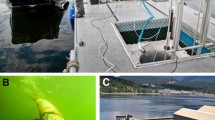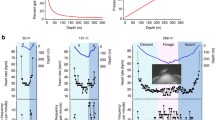Abstract
When aquatically adapted mammals and birds swim submerged, they exhibit a dive response in which breathing ceases, heart rate slows, and blood flow to peripheral tissues and organs is reduced. The most intense dive response occurs during forced submersion which conserves blood oxygen for the brain and heart, thereby preventing asphyxiation. In free-diving animals, the dive response is less profound, and energy metabolism remains aerobic. However, even this relatively moderate bradycardia seems diametrically opposed to the normal cardiovascular response (i.e., tachycardia and peripheral vasodilation) during physical exertion. As a result, there has been a long-standing paradox regarding how aquatic mammals and birds exercise while submerged. We hypothesized based on cardiovascular modeling that heart rate must increase to ensure adequate oxygen delivery to active muscles. Here, we show that heart rate (HR) does indeed increase with flipper or fluke stroke frequency (SF) during voluntary, aerobic dives in Weddell seals (HR = 1.48SF − 8.87) and bottlenose dolphins (HR = 0.99SF + 2.46), respectively, two marine mammal species with different evolutionary lineages. These results support our hypothesis that marine mammals maintain aerobic muscle metabolism while swimming submerged by combining elements of both dive and exercise responses, with one or the other predominating depending on the level of exertion.




Similar content being viewed by others
Abbreviations
- ECG:
-
Electrocardiogram
- Hb:
-
Hemoglobin
- HR:
-
Heart rate (min−1)
- kPa:
-
Kilopascal
- Mb:
-
Myoglobin
- O2 :
-
Oxygen
- ODBA:
-
Overall dynamic body acceleration
- P 50 :
-
Oxygen partial pressure (mm Hg or kPa) at 50 % saturation
- RMSD:
-
Root-mean-square difference
- SF:
-
Flipper or fluke stroke frequency (min−1)
- VHF:
-
Very high frequency
- \( \dot{V}_{{{\text{O}}_{2} }} \) :
-
Rate of oxygen consumption (ml O2 min−1 kg−1)
- \( \dot{V}_{{{\text{MO}}_{2} }} \) :
-
Multiple of resting skeletal muscle oxygen consumption
References
Andrews RD, Jones DR, Williams JD, Thorson PH, Oliver GW, Costa DP, Le Boeuf BJ (1997) Heart rates of northern elephant seals diving at sea and resting on the beach. J Exp Biol 200:2083–2095
Bevan RM, Butler PJ (1992) Cardiac output and blood flow distribution during swimming and voluntary diving of the tufted duck (Aythya fuligula). J Exp Biol 168:199–217
Blix AS, Folkow B (1983) Cardiovascular adjustments to diving in mammals and birds. In: Shepard JT, Abboud FM (eds) Handbook of Physiology, vol. 3, sec 2. American Physiological Society, Bethesda, pp 917–945
Blix AS, Kjekshus JK, Enge I, Bergan A (1976) Myocardial blood flow in the diving seal. Acta Physiol Scand 96:277–280
Butler PJ (1988) The exercise response and the “classical” diving response during natural submersion in birds and mammals. Can J Zool 66:29–39
Butler PJ, Jones DR (1997) Physiology of diving birds and mammals. Physiol Rev 77:837–899
Butler PJ, Woakes AJ, Boyd IL, Kanatous S (1992) Relationship between heart rate and oxygen consumption during steady-state swimming in California sea lions. J Exp Biol 170:35–42
Castellini MA, Murphy BJ, Fedak M, Ronald K, Gofton N, Hochachka PW (1985) Potentially conflicting metabolic demands of diving and exercise in seals. J Appl Physiol 58:392–399
Davis RW, Kanatous SB (1999) Convective oxygen transport and tissue oxygen consumption in Weddell seals during aerobic dives. J Exp Bio 202:1091–1113
Davis RW, Castellini MA, Kooyman GL, Maue R (1983) Renal glomerular filtration rate and hepatic blood flow during voluntary dives in Weddell seals. Am J Phys 245:R743–R748
Davis RW, Fuiman LA, Williams TM, Horning M, Hagey W (2003) Classification of Weddell seal dives based on three-dimensional movements and video recorded observations. Mar Ecol Prog Ser 264:109–122
Elsner R, Gooden B (1983) Diving and asphyxia. Cambridge University Press, Cambridge, pp 1–59
Elsner RW, Franklin DL, VanCitters RL (1964) Cardiac output during diving in an unrestrained sea lion. Nature 202:809–810
Fedak MA (1986) Diving and exercise in seals: a benthic perspective. In: Brubakk AO, Kanwisher JW, Sundnes G (eds) Diving in animals and man. Tapir, Trondheim, pp 11–32
Gordon MS, Boetius I, Evans DH, McCarthy R, Oglesby LC (1969) Aspects of the physiology of terrestrial life in amphibious fishes. J Exp Biol 50:141–149
Grega GJ, Adamski SW (1987) Patterns of constriction produced by vasoactive agents. Fed Proc 46:270–275
Guyton GP, Stanek KS, Schneider RC, Hochachka PW, Hurford WE, Zapol DG, Liggins GC, Zapol WM (1995) Myoglobin saturation in free-diving Weddell seals. J Appl Physiol 79:1148–1155
Hill RD, Schneider RC, Liggins GC, Schuette AH, Elliott RL, Guppy M, Hochachka PW, Qvist J, Falke KJ, Zapol WM (1987) Heart rate and body temperature during free diving of Weddell seals. Am J Physiol 253:R344–R351
Hindell MADJ, Slip HR, Bryden MM (1992) Physiological implications of continuous, prolonged and deep dives of the southern elephant seal (Mirounga leonina). Can J Zool 70:370–379
Hindle AG, Young BL, Rosen DAS, Haulena M, Trites AW (2010) Dive response differs between shallow- and deep-diving Steller sea lions (Eumetopias jubatus). J Exp Mar Biol Ecol 394:141–148
Irving L, Scholander PF, Grinnell SW (1942) The regulation of arterial blood pressure in the sea during diving. Am J Physiol 135:557–566
Jobsis PD, Ponganis PJ, Kooyman GL (2001) Effects of training on forced submersion responses in harbor seals. J Exp Bio 204:3877–3885
Kerem D, Elsner R (1973) Cerebral tolerance to asphyxial hypoxia in the harbor seal. Resp Physiol 19:188–200
Kjekshus JK, Blix AS, Elsner R, Hol R, Amundsen E (1982) Myocardial blood flow and metabolism in the diving seal. Am J Physiol 242:R97–R104
Kooyman GL (1985) Physiology without restraint in diving mammals. Mar Mammal Sci 1:166–178
Kooyman GL, Campbell WB (1972) Heart rates in freely diving Weddell Seals, Leptonychotes weddelli. Comp Biochem Physiol 43A:31–36
Kooyman GL, Wahrenbrock EA, Castellini MA, Davis RW, Sinnett EE (1980) Aerobic and anaerobic metabolism during voluntary diving in Weddell seals: evidence of preferred pathways from blood chemistry and behavior. J Comp Physiol B 138:335–346
Kooyman GL, Ponganis PJ, Howard RS (1999) Diving animals. In: Lundgren CEG, Miller JN (eds) The lung at depth vol 132. Marcel Dekkar Inc, New York
Le Boeuf BJ, Naito BJ, Huntley AC, Asaga T (1989) Prolonged, continuous, deep diving by northern elephant seals. Can J Zool 67:2514–2519
Leivestad H, Andersen HT, Scholander PF (1957) Physiological response to air exposure in codfish. Science 126:9
Noren SR, Williams TM, Pabst DA, McLellan WA, Dearolf JL (2001) The development of diving in marine endotherms: preparing the skeletal muscles of dolphins, penguins, and seals for activity during submergence. J Comp Phys B 171:127–134
Ponganis PJ, Kooyman GL, Zornow MH, Castellini MA, Croll DA (1990) Cardiac output and stroke volume in swimming harbor seals. J Comp Physiol B 160:473–482
Ponganis PJ, Kooyman GL, Castellini MA, Ponganis EP, Ponganis KV (1993) Muscle temperature and swim velocity profiles during diving in a Weddell seal, Leptonychotes weddellii. J Exp Biol 183:341–348
Ponganis PJ, Kooyman GL, Winter LM, Starke LN (1997) Heart rate and plasma lactate responses during submerged swimming and trained diving in California sea lions, Zalophus californianus. J Comp Physiol B 167:9–16
Qvist J, Hill RD, Schneider RC, Falke KJ, Liggins GC, Guppy M, Elliot RL, Hochachka PW, Zapol WM (1986) Hemoglobin concentrations and blood gas tensions of free diving Weddell seals. J Appl Physiol 61:1560–1569
Scholander PF (1940) Experimental investigations on the respiratory function in diving mammals and birds. Hvalradets Skr 22:l-131
Scholander PF (1964) The master switch of life. Sci Am 209:92–106
Soini HO, Takala J, Nordin AJ, Makisalo HJ, Hockerstedt KAV (1992) Peripheral and liver tissue oxygen tensions in hemorrhagic shock. Critical Care Med 20:1330–1334
Stone HL, Gray K, Stabe R, Chandler JM (1973) Renal blood flow in a diving trained sea lion. Nature 242:530–531
Taylor CR, Heglund NC, McMahon TA, Looney TR (1980) Energetic cost of generating muscular force during running. J Exp Biol 86:9–18
White FN, Ikeda M, Elsner RW (1973) Adrenergic innervation of large arteries in the seal. Comp Gen Pharmac 4:271–276
Williams TM (1983) Locomotion in the North American mink, a semi-aquatic mammal. II. The effect of an elongate body on running energetics and gait patterns. J Exp Biol 105:283–295
Williams TM, Kooyman GL, Croll DA (1991) The effect of submergence on heart rate and oxygen consumption of swimming seals and sea lions. J Comp Physiol B 160:637–644
Williams TM, Fuiman LA, Horning M, Davis RW (2004) The cost of foraging by a marine predator, the Weddell seal Leptonychotes weddellii: pricing by the stroke. J Exp Biol 207:973–982
Zapol WM, Liggins GC, Schneider RC, Qvist J, Snider MT, Creasy RK, Hochachka PW (1979) Regional blood flow during simulated diving in the conscious Weddell seal. J Appl Physiol 47:968–973
Acknowledgments
We thank the following people for field assistance: W. Buitenkyk, G. Davis, I. Davis, T. Kendall, B. Richter, and D. Williams. Field and statistical assistance was provided by E. Farrell and L. Fuiman. Assistance with instrument development was provided by W. Hagey. This study was supported by Grants from the Office of Naval Research (N000140811273 to T.M. Williams) and National Science Foundation Polar Programs (OPP0739390 to R. Davis, OPP0739163 to T.M. Williams). We also thank P. Berry and the dolphin behavior team at EPCOT Center, Disney World for providing and training the dolphins in this study and for assisting in the research. All experimental procedures were conducted in accordance with the Institutional Animal Use and Care Committees at Texas A&M University, the University of California at Santa Cruz, and Disney EPCOT. This study was conducted under Marine Mammal Permit Nos. 984-1814-01 and 984-1587-00.
Author information
Authors and Affiliations
Corresponding author
Rights and permissions
About this article
Cite this article
Davis, R.W., Williams, T.M. The marine mammal dive response is exercise modulated to maximize aerobic dive duration. J Comp Physiol A 198, 583–591 (2012). https://doi.org/10.1007/s00359-012-0731-4
Received:
Revised:
Accepted:
Published:
Issue Date:
DOI: https://doi.org/10.1007/s00359-012-0731-4




